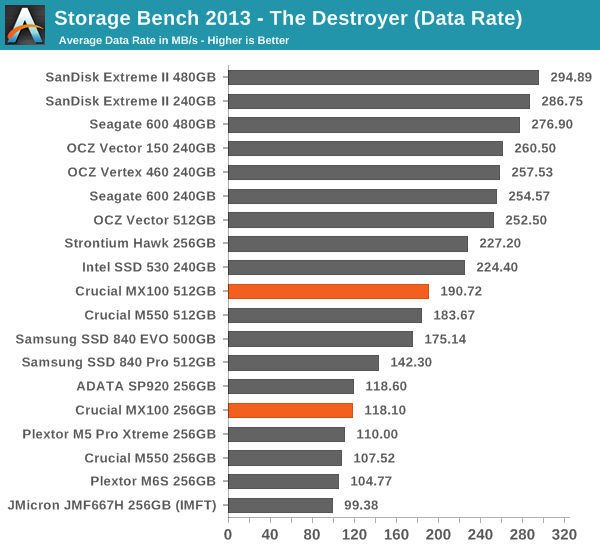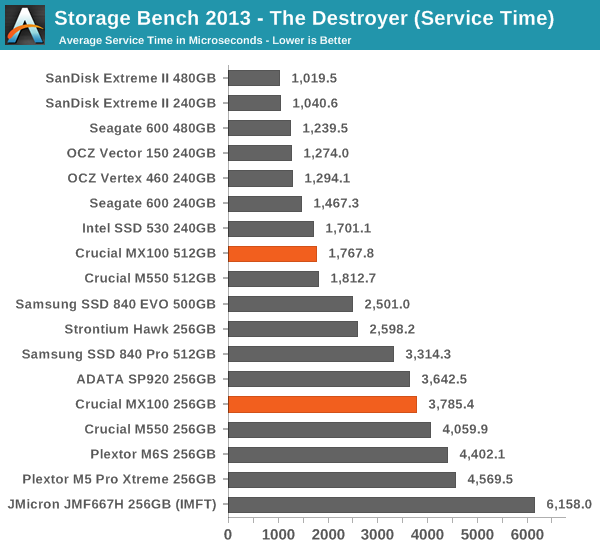Crucial MX100 (256GB & 512GB) Review
by Kristian Vättö on June 2, 2014 3:00 PM ESTAnandTech Storage Bench 2013
Our Storage Bench 2013 focuses on worst-case multitasking and IO consistency. Similar to our earlier Storage Benches, the test is still application trace based - we record all IO requests made to a test system and play them back on the drive we are testing and run statistical analysis on the drive's responses. There are 49.8 million IO operations in total with 1583.0GB of reads and 875.6GB of writes. I'm not including the full description of the test for better readability, so make sure to read our Storage Bench 2013 introduction for the full details.
| AnandTech Storage Bench 2013 - The Destroyer | ||
| Workload | Description | Applications Used |
| Photo Sync/Editing | Import images, edit, export | Adobe Photoshop CS6, Adobe Lightroom 4, Dropbox |
| Gaming | Download/install games, play games | Steam, Deus Ex, Skyrim, Starcraft 2, BioShock Infinite |
| Virtualization | Run/manage VM, use general apps inside VM | VirtualBox |
| General Productivity | Browse the web, manage local email, copy files, encrypt/decrypt files, backup system, download content, virus/malware scan | Chrome, IE10, Outlook, Windows 8, AxCrypt, uTorrent, AdAware |
| Video Playback | Copy and watch movies | Windows 8 |
| Application Development | Compile projects, check out code, download code samples | Visual Studio 2012 |
We are reporting two primary metrics with the Destroyer: average data rate in MB/s and average service time in microseconds. The former gives you an idea of the throughput of the drive during the time that it was running the test workload. This can be a very good indication of overall performance. What average data rate doesn't do a good job of is taking into account response time of very bursty (read: high queue depth) IO. By reporting average service time we heavily weigh latency for queued IOs. You'll note that this is a metric we have been reporting in our enterprise benchmarks for a while now. With the client tests maturing, the time was right for a little convergence.

Quite surprisingly, the MX100 is slightly faster than the M550 in our 2013 Storage Bench. The differences are not significant, but it's still surprising given that M550 is supposed to be Crucial's higher performing drive. Especially at 256GB this is odd because the M550 has lower capacity NAND that should result in more parallelism and thus more performance, but that doesn't seem to be that case. I'm guessing that Crucial has been able to tweak the firmware to unleash more performance from the Marvell 9189 controller, which would explain why the MX100 is faster than the M550. Then again, the ADATA SP920 with 128Gbit NAND and Micron designed firmware is also faster than the 256GB M550, so it looks like M550 doesn't take full advantage of the lower capacity NAND.











50 Comments
View All Comments
extide - Monday, June 2, 2014 - link
Wow, 256Gbit dies! That would mean up to 2TB in a standard 2.5" SSD -- Crazy!hojnikb - Monday, June 2, 2014 - link
Actually one could fit 4TB into a standard 2.5" (or even 8GB when using 32 packages) but the problem is, as far as i can tell, no single controller can adress so much space.hojnikb - Monday, June 2, 2014 - link
*TB obviously :)extide - Monday, June 2, 2014 - link
Yeah but it's a chicken and egg thing I think. There seems to be a max price cap of about $600 for these SSD's, and so for 64gbit NAND that was ~512GB and 128Gbit NAND it is about 1TB. When they design a controller to exist during the lifetime of 256Gbit NAND there is a good chance that someone is actually going to make a 2TB drive because that much NAND would then fit inside that 'max price' so they will design the controller for that max amount. And in the same vein a contrller for the 128Gbit era would be 'OK' with a 1TB max.... if that makes sense, heh.hojnikb - Monday, June 2, 2014 - link
Also, there is already 2TBs drives out thre on the old 64Gbit flash :)danwat1234 - Monday, January 26, 2015 - link
Intel S3500 2TB exists, not sure if it works in laptops thoughfruitcrash - Wednesday, June 4, 2014 - link
It's not that you can't address it (for ONFI NAND you can use the Volume Select command), but that you can't have more than about 8 chips on a channel because of capacitive loading.extide - Monday, June 2, 2014 - link
NOTE: I am talking about the future NAND, NOT what is used in this drive.hojnikb - Monday, June 2, 2014 - link
Still, 256Gbit dies can can't help you much, if controller can't adress that much space. As i've said above, once could fit 4-8TB of flash, it's just isn't possible yet.hojnikb - Monday, June 2, 2014 - link
Any details on the 128GB version ?I've read somewhere, that it will be using the old 20nm flash...